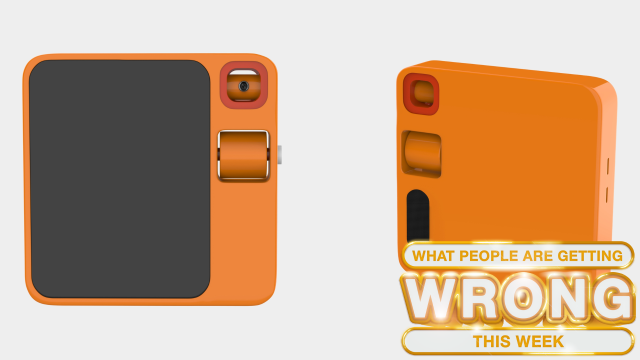Tech-interested people and early adopters have been extremely hyped for portable/wearable AI assistants since the Humane AI pin was announced in 2023. Sadly, blue sky techie visions of an easier, glossier, “in the flow” lifestyle powered by an ever-ready AI brain have been blown apart by the release of the first two products in the space. They are just not very good. At least for now.
Reviews of both The Humane AI Pin and Teenage Engineering’s Rabbit R1 are are not positive. The general consensus: maybe it would be cool to have a personal artificial intelligence device you could whip out at a moment’s notice to augment your brain, but neither of these products are that. Not only do they not live up to their hype, they don’t work very well.
The Humane AI Pin is the more ambitious, “serious” product of the pair. Retailing for $US699 and requiring a monthly subscription fee to function, the Pin is billed as “your assistant and second brain, allowing you to be present and in flow,” but in reality, the AI is slow and often wrong, the battery life is short, and the UI is terrible, leading even-handed tech reviewer Marques Brownlee to declare the Humane AI Pin “the worst product I have ever reviewed.”
Although it functions a lot like the AI Pin, the Rabbit R1 is more toy-like, both in appearance and price. It’s safety orange with a big control knob, and it “only” costs $US199 with no subscription fee. But the AI is often wrong, the battery life is short, and the UI is terrible, leading Marques Brownlee to declare the R1 “Barely Reviewable.”
And all this is leaving aside the unanswered question at the core of both devices: do people even want a dedicated AI device? As many have pointed out, neither the Pin nor the Rabbit do much of anything that your phone can’t already do.
“Trust me” products and paying full price for half-baked things
Both the Rabbit and the Pin promise more features in the future, including seamless integration with your other devices, and the ability to have your AI assistant complete multi-step tasks with a simple command like, “book me a vacation in Mexico.” It all hints at a phone-free, AI-powered future that has a certain appeal. But for now, the Pin and Rabbit are “trust me” products: things that could be really cool—once the software is updated, the integration is completed, the bugs are worked out, etc.
Improving an existing product after you buy it through software updates is one thing—video games like No Man’s Sky and Fallout 76 were massive disappointments at launch, but are pretty good now, and Tesla’s self-driving feature is now more than an empty promise on the car’s touchscreens—but there’s nothing that guarantees Humane’s Pin won’t go the way of the Juicero, or that Teenage Engineering won’t forget the R1 and go back to making overpriced (but extremely popular) drum machines, leaving consumers with expensive paperweights they can store next their Zune player.
Avoid early adopter regret by living in the past
To avoid the buyer’s regret that can come from this almost-vaporware, you can simply wait to purchase tech products that are at least 18 months old. You’ll skip all those buggy launches, every game console you buy will have plenty of games, and your personal AI assistant will have tons of apps. If you wait even longer, say three years, you could save a lot of money by buying everything when the price is lowered because the version 2.0 is coming to market.
Letting the dust clear before jumping into a new thing is what a most people do anyway, but that waiting is difficult for early adopters. Luckily, I have a solution. It involves virtual time travel. If you were to carefully curate the tech media you consume, and have every device you own only serve information that’s a few years out-of-date, it would make last-generation gear new, to you at least. This would have been nearly impossible in the past, but it’s doable now. To make it happen, you’ll first need to buy a personal AI assistant like the Rabbit R1 or the Humane AI Pin. With your AI assistant is in hand, explain the situation in common English. Tell it to back-date any tech-related story by three years so you never know when anything is coming out. It will seamlessly integrate with your phone, computer, and other devices, translating your simple command into complex actions, and editing webpages and YouTube videos on the fly so you can—on second thought, that won’t work. Maybe just wait until the things work.
A brief, unrelated note about whether Donald Trump farts a lot
Last week in this column I evaluated the truth or falsity of various stories about Donald Trump’s criminal trial. I rated the idea that the ex-president farts in court as “false,” but I heard from Brett Meiselas of Meidas Touch, the source of the “news,” who wrote, “Our coverage is based entirely on facts by experts, and we would not report something unless it is well sourced and corroborated.”
Perhaps the journalists in the courtroom feel that reporting on flatulence is beneath them, so they don’t want to go on record. Anyway, I’ve changed the designation of “Does Donald Trump fart in court?” to “unconfirmed.” No one can prove he didn’t fart, and Meiselas passionately stands behind his story, so sure, whatever. Maybe he farts all the time.
(I don’t want to think about Donald Trump anymore because it’s depressing.)

Leave a Reply
You must be logged in to post a comment.